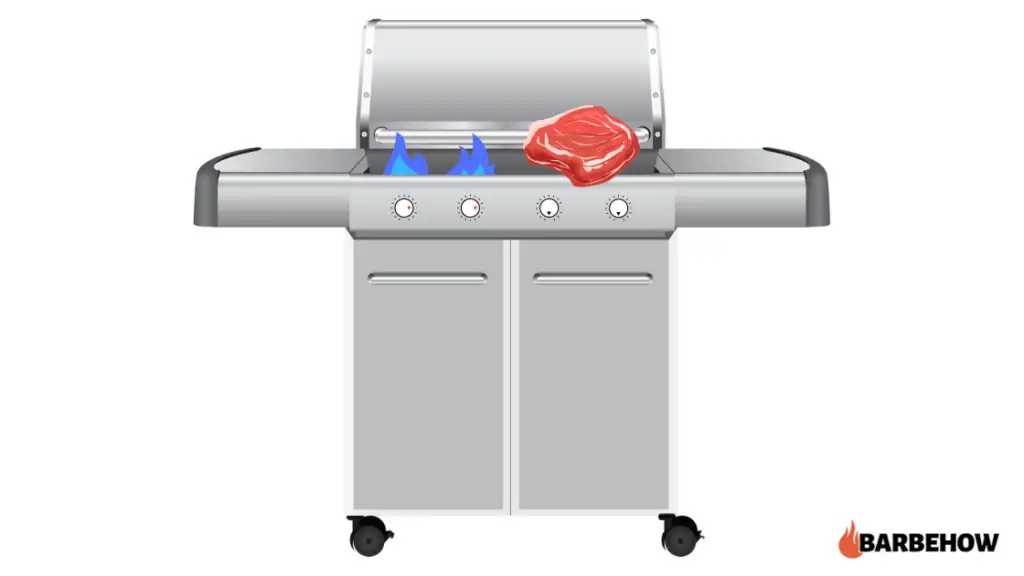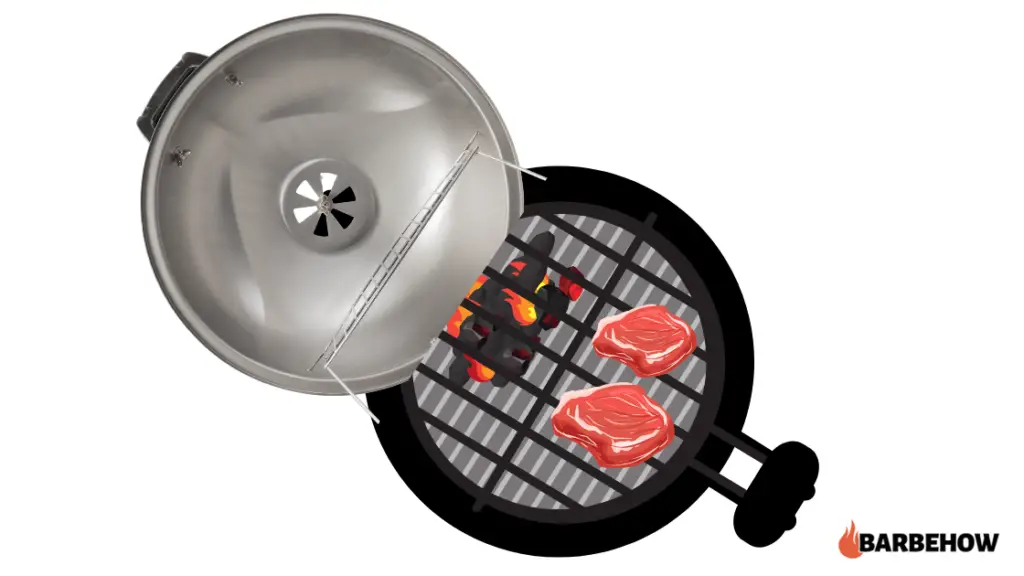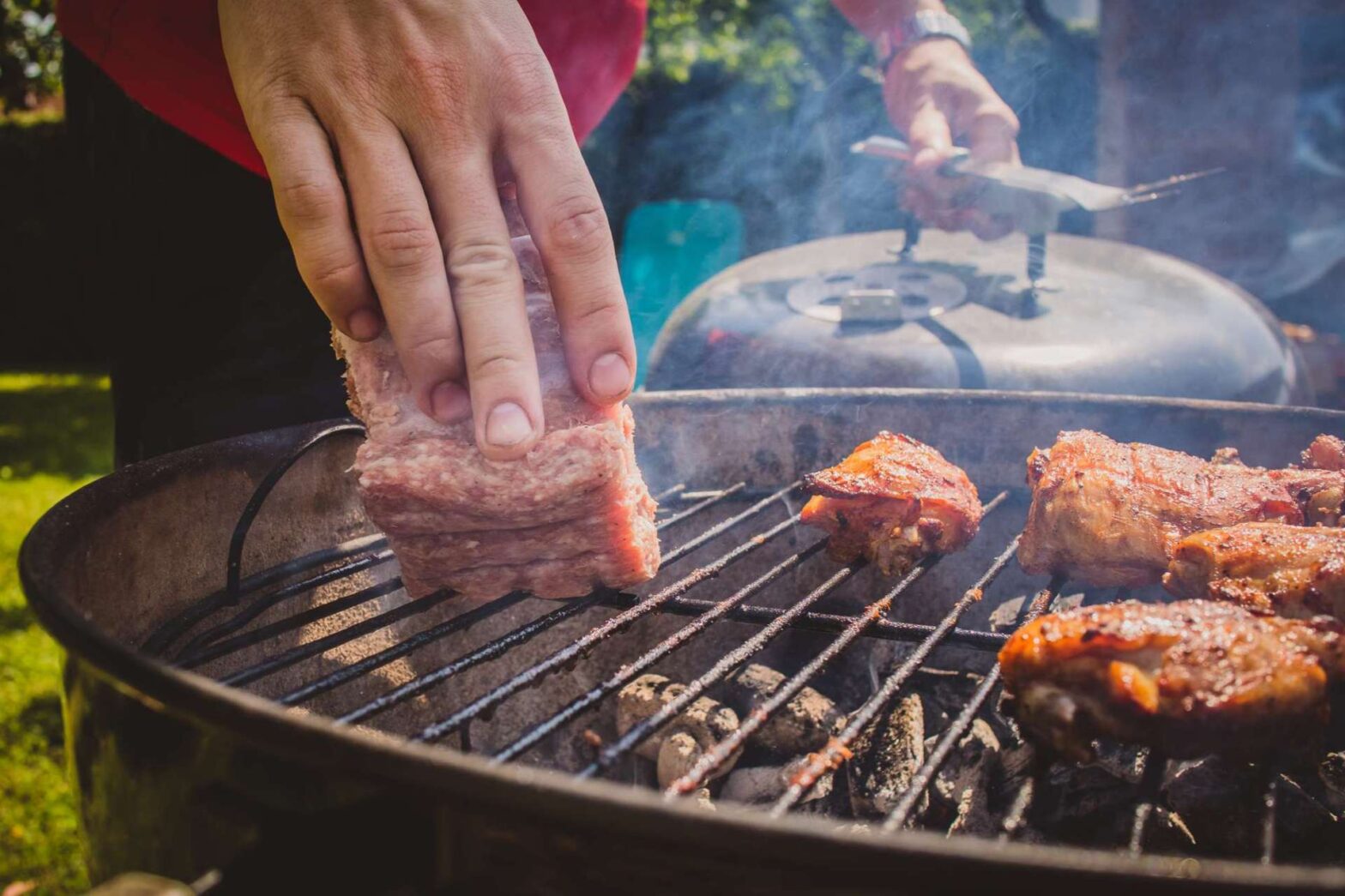Should you grill with the lid up or down? This is a question that, at some point, every novice griller asks themselves. The answer comes down to the heat of the grill and the thickness of the meat.
When grilling with an open lid, the temperature from under the meat is higher than the temperature of the air above it. When grilling with the lid closed, convection occurs, which equalizes the temperature and promotes cooking on both sides.
Today, we will put to rest your long-held thoughts about grilling with—and without—a lid. We will explore how these two methods are fundamentally different and when which method is appropriate for grilling meat.
When to Grill With a Lid
If you want to grill steaks thicker than 1½ inches or larger slabs of meat, you should put the lid on. When you put the lid on the grill, it creates a convection effect inside the grill.
Convection—a circular movement of heat—occurs when warm air rises and cool air sinks, and this cycle repeats. This heat helps cook the meat on both sides so that when it is browned and caramelized on the outside, it is also cooked through on the inside.
Meats that are generally thicker than one and a half inches and therefore are best grilled with a lid include:
- The ribeye;
- The T-bone;
- The strip steak;
- The tenderloin steak;
- Filet mignon (the smaller tip of tenderloin);
- Thick-cut bird breasts or thighs;
- Thick-cut pork chops.
How to Grill With a Lid
Now come the more detailed instructions. If you are grilling with the lid closed, you need to set your grill up in a way that yields good convection. Thick-cut steaks and large cuts of meat are best grilled over gentle, indirect heat.

For indirect heat on a gas grill, preheat the unit for at least 15 minutes by turning half the burners to medium and leaving the other half off. The side with the burner gives you direct heat for searing meat; the other gives you indirect heat for letting it cook low and slow.

For indirect heat on a charcoal grill, wait until the coals turn white and ashy, then rake them over to one side while keeping the other charcoal-free. The side with the hot coals gives you direct, searing heat. The side without them gives you indirect, cooking heat.
Gentle, indirect heat is better than intense, direct heat because it allows the inside of the meat to cook through before the outside gets charred to oblivion. We’ve all cooked a steak over a little too much heat at one time or another. The result is a steak that’s rare when you cut into it, but not in a good way, and as tough as a leather shoe when you bite into it.
So the technique for grilling with a lid is as follows: With the lid off, sear the steak on both sides until you get a nicely browned crust, then move it over to indirect heat and finish cooking with the lid on.
When to Grill Without a Lid
You always see this kind of grilling in barbecue commercials, movies about summer barbecues, and other stereotypical depictions of grilling meat. Dad is on grill duty with his apron on, flipping and turning burgers and hot dogs while smoke rises from the open kettle barbecue.
Grilling without a lid should only be used in one of two cases: 1) for searing thick steaks and 2) for cooking thinly sliced meats or meats less than 1-1½ inches thick.
With thinner cuts of meat, you don’t really need convection heating because the inside cooks almost as quickly as the outside. This tells you that you can take the lid off the grill for flank steaks, fish fillets, burger patties, and hot dogs.
Meats that are typically thinner than one to one-and-a-half inches include:
- Flank steak;
- Thin-cut ranch;
- Thin-cut sirloin steak;
- Thin-cut Denver steak;
- Chicken tenders or butterflied fillets;
- Bacon strips;
- Most cuts of fish;
- Shrimp;
- Thin-cut pork chops;
- Thin-cut lamb chops;
- Hot dogs;
- Burger patties.
How to Grill Without a Lid
When it comes to grilling thin meat without a lid, we always say it’s best to grill it over direct, high heat, so it’s quick. The reason is that thin meat cooks quickly, and you don’t have to worry about the center cooking as fast as the outside because they’re so close together.
High heat also helps you—the griller—achieve that classic look and feel of grilled meat. That said, certain grilling techniques work better than others, and you can use and control heat strategically.
“Coals piled in a double or triple layer burn hotter than coals in a single layer,” barbecue master and culinary writer Steven Raichlen says in his 2001 book, How to Grill: The Complete Illustrated Book of Barbecue Technique.
Raichlen recommends raking the coals in a double layer and a single layer to create a two-zone fire on the charcoal grill. The double layer is for searing and crisping meat, and the single is for cooking it through.
When to Use Both
Just as it makes sense to open or close the lid in certain grilling scenarios, it makes sense to do some of both in others.
For example, if you want to prepare particularly thick steaks at a cookout, you can sear them briefly over intense, direct heat with the lid off, and then finish cooking them over gentle, indirect heat with the lid on.
The same is true if you are grilling hefty salmon fillets. You may want the fish to look and taste slightly charred, and yet you need to make sure the fish is cooked to the minimum temperature in the center when it comes off the grill.
On a charcoal grill, you can create a three-zone fire by piling up two layers of charcoal on one side and a single layer in the middle, leaving the other side charcoal-free. This way, you get high, medium, and indirect heat all at once.
On a gas grill, particularly if you have three or more burners, you can accomplish the same thing by setting one burner to medium-high, the other to medium, and the third to off. The more burners your unit has, the greater the variety of heat you can achieve.
With this technique, you are not only in control of the heat; you get to choose what kind of heat to use simply by moving the meat on the grate—and choice is exactly what you want when on the grill.


